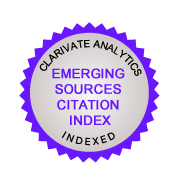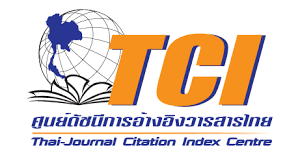Effects of crosslinking agent and biological properties of silk fibroin/gelatin/chitosan ternary system electrospun nanofiber mats.
DOI:
https://doi.org/10.55713/jmmm.v29i4.478Keywords:
Electrospun nanofiber mats, Silk fibroin, Gelatin, Chitosan, Crosslinking agentAbstract
In this study, electrospinning technique was used for ternary system to fabricate nanofiber mats from silk fibroin (SF):gelatin (G):chitosan (C) with various mass ratios i.e. 10:20:0, 10:20:0.5, 10:20:1, 10:20:1.5, 10:20:2, and 20:10:1. An increase in chitosan content of the mats was found to decrease average fiber diameter and with narrow size distribution. Tensile strength of SF:G:C nanofiber having greater SF content was lower than that of the fiber mat having lower SF content. The obtained fiber mats were then crosslinked by three different crosslinking agents including ethanol, glutaraldehyde and 1-ethyl-3-(3-dimethylaminopropyl) carbodiimide hydrochloride (EDC)/N-hydroxysuccinmide (NHS). The smooth fiber with high porosity of the nanofiber mat was observed after crosslinked using EDC/NHS agent. A less swollen fiber was noticed in the fiber mats having higher SF content. The results from in vitro study revealed the good cell adhesion and proliferation of gingival tissues. Such results indicated the potential use of SF:G:C nanofiber mats as membrane application.Downloads
References
J. T. Krauser, B. K. Bartee, and A. K. Garg, “Membrane barriers for guided tissue regeneration,” in Dental Implants: the Art and Science, C. A. Babbush, J. A. Hahn, J. T. Krauser, and J. L. Rosenlicht, Eds. 2nd ed., Missouri: Saunders, 2011, pp. 181-215.
Y. Zhang X. Zhang, B. Shi, and R. J. Miron, “Membranes for guided tissue and bone regeneration,” Oral & Maxillofacial Surgery, vol. 1(1), pp. 1-10, 2013. DOI: https://doi.org/10.13172/2052-7837-1-1-451
R. Dimitriou, G. I. Mataliotakis, G. M. Calori, and P. V. Giannoudis, “The role of barrier membranes for guided bone regeneration and restoration of large bone defects: current experimental and clinical evidence,” BMC Medicine, vol. 10, pp. 1-24, 2012. DOI: https://doi.org/10.1186/1741-7015-10-81
M. Mour, D. Das, T. Winkler, E. Hoenig, G. Mielke, M. M. Morlock, and A. F. Schilling, “Advances in porous biomaterials for dental and orthopaedic Applications,” Materials, vol. 3, pp. 2947-2974, 2010. DOI: https://doi.org/10.3390/ma3052947
A. L. Andrady, Science and technology of polymer nanofibers. Hoboken: John Wiley & Sons, Inc. 2007. DOI: https://doi.org/10.1002/9780470229842
S. Zarkoob RKE, D. H. Reneker, S. D. Hudson, D. Ertley, and W. W. Adams, “Structure and morphology of electrospun silk nanofibers,” Polymer, vol. 45, pp 3973-3977, 2004. DOI: https://doi.org/10.1016/j.polymer.2003.10.102
Z.-M. Huang, Y. Z. Zhang, S. Ramakrishna, and C. T. Lim, “Electrospinning and mechanical characterization of gelatin nanofibers,” Polymer, vol. 45, pp. 5361-5368, 2004. DOI: https://doi.org/10.1016/j.polymer.2004.04.005
K. Ohkawa, D. Cha, H. Kim, A. Nishida, and H. Yamamoto, “Electrospinning of Chitosan,” Macromolecular Rapid Communications, vol. 25, pp. 1600-1605, 2004. DOI: https://doi.org/10.1002/marc.200400253
K.-H. Kim, L. Jeong, and H.-N. Park, “Biological efficacy of silk fibroin nanofiber membranes for guided bone regeneration”, Journal of Biotechnology, vol. 120, pp. 327-39, 2005. DOI: https://doi.org/10.1016/j.jbiotec.2005.06.033
C. Vepari and D. Kaplan. “Silk as a Biomaterial,” Progress in polymer science, vol. 32, pp. 991- 1007, 2007. DOI: https://doi.org/10.1016/j.progpolymsci.2007.05.013
U-J. Kim, J. Park, H. Joo Kim, M. Wada, and D. L. Kaplan, “Three-dimensional aqueousderived biomaterial scaffolds from silk fibroin,” Biomaterials, vol. 26, pp. 2775-85, 2005. DOI: https://doi.org/10.1016/j.biomaterials.2004.07.044
B. B. Mandal, J. K. Mann, and S. C. Kundu, “Silk fibroin/gelatin multilayered films as a model system for controlled drug release,” European Journal of Pharmaceutical Sciences, vol. 37, pp. 160-171, 2009. DOI: https://doi.org/10.1016/j.ejps.2009.02.005
J. A. Matthews, G. E. Wnek, D. G. Simpson, and G. L. Bowlin, “Electrospinning of collagen nanofibers,” Biomacromolecules, vol. 3, pp. 232-238, 2002. DOI: https://doi.org/10.1021/bm015533u
R. Jayakumar, M. Prabaharan, P. T. Sudheesh Kumar, S. V. Nair, and H. Tamura, “Biomaterials based on chitin and chitosan in wound dressing applications,” Biotechnology Advances, vol. 29, pp. 322-237, 2011. DOI: https://doi.org/10.1016/j.biotechadv.2011.01.005
M-H. Ho, C-C. Hsieh, S-W. Hsiao. and D. V. H. Thien, “Fabrication of asymmetric chitosan GTR membranes for the treatment of periodontal disease,” Carbohydrate Polymers, vol. 79, pp. 955-963, 2010. DOI: https://doi.org/10.1016/j.carbpol.2009.10.031
F. Croisier and C. Jérôme, “Chitosan-based biomaterials for tissue engineering,” European Polymer Journal, vol. 49, pp. 780-792, 2013. DOI: https://doi.org/10.1016/j.eurpolymj.2012.12.009
C. Huang, R. Chen, Q. Ke, Y. Morsi, K. Zhang, and X. Mo, “Electrospun collagen–chitosan– TPU nanofibrous scaffolds for tissue engineered tubular grafts,” Colloids and Surfaces B: Biointerfaces, vol. 82, pp. 307-315, 2011. DOI: https://doi.org/10.1016/j.colsurfb.2010.09.002
K. E. Park, S. Y. Jung, S. J. Lee, B. M. Min, and W. H. Park, “Biomimetic nanofibrous scaffolds: Preparation and characterization of chitin/silk fibroin blend nanofibers,” International Journal of Biological Macromolecules, vol. 38, pp. 165-173, 2006. DOI: https://doi.org/10.1016/j.ijbiomac.2006.03.003
C. Meechaisue, P. Wutticharoenmongkol and R. Waraput, “Preparation of electrospun silk fibroin fiber mats as bone scaffolds: a preliminary study,” Biomedical Materials, vol. 2, pp. 181-188, 2007. DOI: https://doi.org/10.1088/1748-6041/2/3/003
Q. Shi, Y. Li, J. Sun, H. Zang, L. Chen, B. Chen, H. Yang, and Z. Wang Z, “The osteogenesis of bacterial cellulose scaffold loaded with bone morphogenetic protein-2,” Biomaterials, vol. 33, pp. 6644-6649, 2012. DOI: https://doi.org/10.1016/j.biomaterials.2012.05.071
K. T. Shalumon, K. H. Anulekha, K. P. Chennazhi, H. Tamura, S. V. Nair, and R. Jayakumar, “Fabrication of chitosan/poly(caprolactone) nanofibrous scaffold for bone and skin tissue engineering,” International Journal of Biological Macromolecules, vol. 48, pp. 571-576, 2011. DOI: https://doi.org/10.1016/j.ijbiomac.2011.01.020
C. S. Ki, D. H. Baek, K. D. Gang, K. H. Lee, I. C. Um, and Y. H. Park, “Characterization of gelatin nanofiber prepared from gelatin–formic acid solution,” Polymer, vol. 46, pp. 5094- 5102, 2005. DOI: https://doi.org/10.1016/j.polymer.2005.04.040
Y. Z. Zhang, J. Venugopal, Z. M. Huang, C. T. Lim, and S. Ramakrishna, “Crosslinking of the electrospun gelatin nanofibers,” Polymer, vol. 47, pp. 2911-2917, 2006. DOI: https://doi.org/10.1016/j.polymer.2006.02.046
P. Jetbumpenkul, P. Amornsudthiwat, S. Kanokpanont, and S. Damrongsakkul, “Balanced electrostatic blending approach – An alternative to chemical crosslinking of Thai silk fibroin/gelatin scaffold,” International Journal of Biological Macromolecules, vol. 50, pp. 7-13, 2012. DOI: https://doi.org/10.1016/j.ijbiomac.2011.08.028
M. Okhawilai, R. Rangkupan, S. Kanokpanont, and S. Damrongsakkul, “Preparation of Thai silk fibroin gelatin electrospun fiber mats for controlled release applications,” International Journal of Biological Macromolecules, vol. 46, pp. 544-550, 2010 DOI: https://doi.org/10.1016/j.ijbiomac.2010.02.008
R. L. Klein and H. Edwin, “X-ray diffraction studied of the crystalline structure of silk fibroin,” Proc SDAcadSci. vol. 32, pp. 52-56, 1953.
W. H. Park, L. Jeong, D. I. Yoo, and S. Hudson, “Effect of chitosan on morphology and conformation of electrospun silk fibroin nanofibers,” Polymer, vol. 45, pp. 7151-7157, 2004. DOI: https://doi.org/10.1016/j.polymer.2004.08.045
Y. Zhou, H. Yang, X. Liu, J. Mao, S. Gu, and W. Xu, “Electrospinning of carboxyethyl chitosan/poly(vinyl alcohol)/silk fibroin nanoparticles for wound dressings,” International journal of biological macromolecules, vol. 53, pp. 88-92, 2013. DOI: https://doi.org/10.1016/j.ijbiomac.2012.11.013
E. S. Gil, D. J. Frankowski, S. M. Hudson, and R. J. Spontak, “Silk fibroin membranes from solvent-crystallized silk fibroin/gelatin blends: Effects of blend and solvent composition,” Materials Science and Engineering: C, vol. 27, pp. 426-431, 2007. DOI: https://doi.org/10.1016/j.msec.2006.05.017
R. Liu, J. Ming, H. Zhang, and B. Zuo, “EDC/NHS crosslinked electrospun regenerated tussah silk fibroin nanofiber mats,” Fibers and Polymers, vol. 13, pp. 613-617, 2012. DOI: https://doi.org/10.1007/s12221-012-0613-y
Q. Yu, Y. Song, X. Shi, C. Xu, and Y. Bin, “Preparation and properties of chitosan derivative/poly(vinyl alcohol) blend film crosslinked with glutaraldehyde,” Carbohydrate Polymers, vol. 84, pp. 465-470, 2011. DOI: https://doi.org/10.1016/j.carbpol.2010.12.006
T. H. Nguyen and B. T. Lee, “Fabrication and characterization of cross-linked gelatin electrospun nano-fibers,” Journal of Biomedical Science and Engineering, vol. 3, pp. 1117- 1124, 2010. DOI: https://doi.org/10.4236/jbise.2010.312145
Z. She, B. Zhang, C. Jin, Q. Feng, and Y. Xu, “Preparation and in vitro degradation of porous three-dimensional silk fibroin/chitosan scaffold,” Polymer Degradation and Stability, vol. 93, pp. 1316-1322, 2008. DOI: https://doi.org/10.1016/j.polymdegradstab.2008.04.001
S. Zhang, Y. Hang, and X. Yang, “Gelatin nanofibrous membrane fabricated by electrospinning of aqueous gelatin solution for guided tissue regeneration,” Journal of Biomedical Materials Research Part A, vol. 90A, pp. 671-679, 2009. DOI: https://doi.org/10.1002/jbm.a.32136
J. Ratanavaraporn, R. Rangkupan, H. Jeeratawatchai, S. Kanokpanont, and S. Damrongsakkul, “Influences of physical and chemical crosslinking techniques on electrospun type A and B gelatin fiber mats,” International Journal of Biological Macromolecules, vol. 47, pp. 431-438, 2010. DOI: https://doi.org/10.1016/j.ijbiomac.2010.06.008
Downloads
Published
How to Cite
Issue
Section
License
Copyright (c) 2019 Journal of Metals, Materials and Minerals

This work is licensed under a Creative Commons Attribution-NonCommercial-NoDerivatives 4.0 International License.
Authors who publish in this journal agree to the following terms:
- Authors retain copyright and grant the journal right of first publication with the work simultaneously licensed under a Creative Commons Attribution License that allows others to share the work with an acknowledgment of the work's authorship and initial publication in this journal.
- Authors are able to enter into separate, additional contractual arrangements for the non-exclusive distribution of the journal's published version of the work (e.g., post it to an institutional repository or publish it in a book), with an acknowledgment of its initial publication in this journal.












